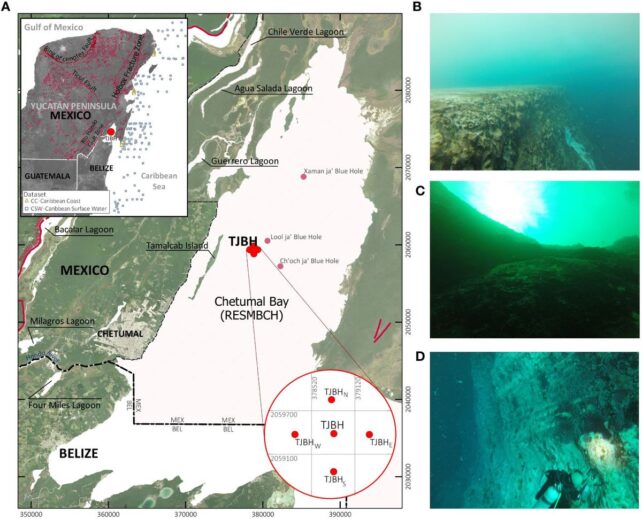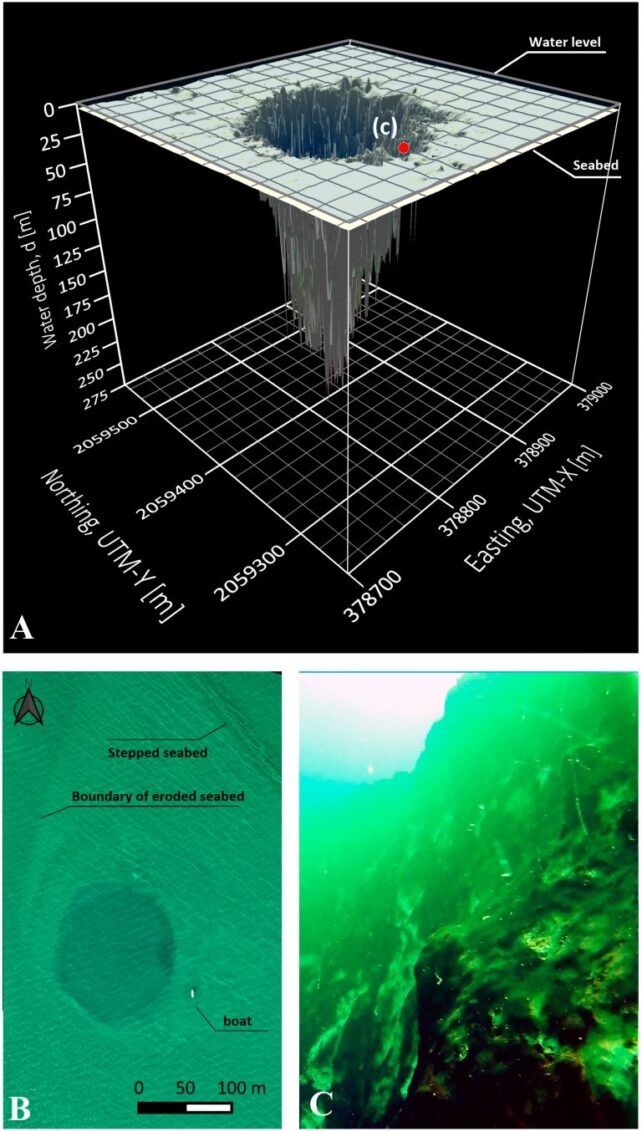ARTICLE AD
There's a gaping hole in the ocean floor so deep that scientists have yet to detect its end.
The 'bottomless' abyss takes the lead as the world's deepest blue hole – beating the Dragon Hole of the south China Sea which bottoms out at 301 meters (988 feet) below sea level.
The Taam Ja' blue hole off the southeast coast of Mexico is more than 100 meters deeper than that. From above, the 150-meter-diameter chasm looks like the pupil of an eye, with a surrounding cerulean seabed for an iris.
The impenetrable hole lies tucked away in a bay of the Yucatan peninsula on the border of Belize. It was formally described in 2023, when scientists declared it the second-largest blue hole in the world based on sonography data.
But here's the catch: This hole is so deep that not even sound, which usually travels so well in water, can bounce off its bottom. Taam Ja' swallows the echoes of high-frequency acoustic waves before they can penetrate more than 274 meters deep.
frameborder="0″ allow="accelerometer; autoplay; clipboard-write; encrypted-media; gyroscope; picture-in-picture; web-share" referrerpolicy="strict-origin-when-cross-origin" allowfullscreen>
One issue could be the known presence of what's described as a pycnocline – a sharp boundary of waters with different densities that can scatter acoustic signals.
To push further and figure out how much further the dark hole goes, researchers at a public center for scientific research in Mexico called El Colegio de la Frontera Sur (ECOSUR) anchored a vessel in the middle of the eye and dropped a line in December of 2023. On the hook was an instrument capable of measuring water pressure, temperature, and conductivity data. When all 500 meters of cable had rolled out, the device had still not reached the bottom.
Because the limestone and gypsum walls of the Taam Ja' blue hole descend at a slight angle rather than parallel, the device ended up 420 meters below sea level.
The very bottom, researchers at ECOSUR write, is "yet to be reached."
 The Taam Ja' blue hole in Mexico's Chetumal Bay. (Alcérreca-Huerta et al., Frontiers in Marine Science, 2024)
The Taam Ja' blue hole in Mexico's Chetumal Bay. (Alcérreca-Huerta et al., Frontiers in Marine Science, 2024)It's possible that on a further expedition, underwater robots could get an instrument deeper, and researchers at ECOSUR are keen to try again.
When their instrument hit the 400 meter-mark inside the hole, real-time data relayed changing water conditions that suddenly converged with those of the Caribbean Sea. This suggests the hole could very well feature a tunnel that connects it to the wider ocean.
 The Taam Ja' Blue Hole as modeled in 2023. (Alcérreca-Huerta et al., Frontiers in Marine Science, 2023).
The Taam Ja' Blue Hole as modeled in 2023. (Alcérreca-Huerta et al., Frontiers in Marine Science, 2023).The Yucatan is famous for its Swiss cheese-like geology, hosting an impressive 10,000 freshwater-filled sinkholes, or cenotes, and an extensive labyrinth of subterranean caves and underwater rivers. Some of these even contain precious archaeological and biological secrets that we never would have known about were it not for the driving force of sheer curiosity.
The cluster of cenotes encircle the Chicxulub crater, and though scientists don't yet know how, they strongly suspect the impact that is famous for killing the dinosaurs and many other animals is in some way responsible for the region's curious geology today.
With the force of one extinction, the stage for a whole new biological niche was chiseled out over time. Despite the dark, low-oxygen environments, cenotes can house thriving ecosystems.
The same could be true of neighboring Taam Ja'.
While biologists are still exploring blue holes around the world to better understand their biological community, in some cases, they have encountered whole new lifeforms.
"Within the depths of [the Taam Ja' blue hole] could also lie a biodiversity to be explored and linked to physicochemical and geomorphological processes, forming a unique biotope," researchers at ECOSUR suggest.
The team is ready to dive in.
The study was published in Frontiers in Marine Science.

 6 months ago
53
6 months ago
53 

